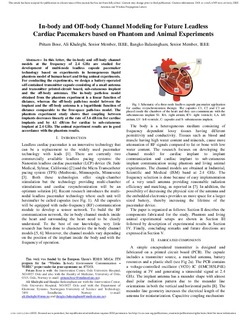| dc.contributor.author | Bose, Pritam | |
| dc.contributor.author | Khaleghi, Ali | |
| dc.contributor.author | Balasingham, Ilangko | |
| dc.date.accessioned | 2019-05-20T08:17:59Z | |
| dc.date.available | 2019-05-20T08:17:59Z | |
| dc.date.created | 2019-01-22T14:37:49Z | |
| dc.date.issued | 2018 | |
| dc.identifier.citation | IEEE Antennas and Wireless Propagation Letters. 2018, 17 (12), 2484-2488. | nb_NO |
| dc.identifier.issn | 1536-1225 | |
| dc.identifier.uri | http://hdl.handle.net/11250/2597953 | |
| dc.description.abstract | In this letter, the in-body and off-body channel models at the frequency of 2.4 GHz are studied for development of multinode leadless capsule pacemaker technology based on experiments in homogeneous liquid phantom model of human heart and living animal experiments. For conducting the experiments, we design a battery-operated self-contained transmitter capsule consisting of a small antenna and transmitter printed-circuit board, subcutaneous implant and the off-body antennas. The in-body path-loss model obtained from the phantom experiment is a linear function of distance, whereas the off-body path-loss model between the implant and the off-body antenna is a logarithmic function of distance comparable to the free-space path-loss model. The phantom experiment study shows that coupling between implants decreases linearly at the rate of 3.6 dB/cm for cardiac implants and by 4.1 dB/cm for cardiac to subcutaneous implant at 2.4 GHz. The animal experiment results are in good accordance with the phantom results. | nb_NO |
| dc.language.iso | eng | nb_NO |
| dc.publisher | IEEE | nb_NO |
| dc.title | In-body and Off-body Channel Modeling for Future Leadless Cardiac Pacemakers based on Phantom and Animal Experiments | nb_NO |
| dc.type | Journal article | nb_NO |
| dc.type | Peer reviewed | nb_NO |
| dc.description.version | acceptedVersion | nb_NO |
| dc.source.pagenumber | 2484-2488 | nb_NO |
| dc.source.volume | 17 | nb_NO |
| dc.source.journal | IEEE Antennas and Wireless Propagation Letters | nb_NO |
| dc.source.issue | 12 | nb_NO |
| dc.identifier.doi | 10.1109/LAWP.2018.2878950 | |
| dc.identifier.cristin | 1663093 | |
| dc.description.localcode | © 2018 IEEE. Personal use of this material is permitted. Permission from IEEE must be obtained for all other uses, in any current or future media, including reprinting/republishing this material for advertising or promotional purposes, creating new collective works, for resale or redistribution to servers or lists, or reuse of any copyrighted component of this work in other works. | nb_NO |
| cristin.unitcode | 194,63,35,0 | |
| cristin.unitname | Institutt for elektroniske systemer | |
| cristin.ispublished | true | |
| cristin.fulltext | original | |
| cristin.fulltext | postprint | |
| cristin.qualitycode | 1 | |
